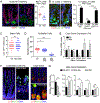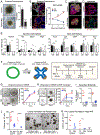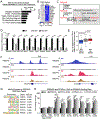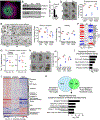PRDM16 Maintains Homeostasis of the Intestinal Epithelium by Controlling Region-Specific Metabolism
- PMID: 31564549
- PMCID: PMC6898778
- DOI: 10.1016/j.stem.2019.08.017
PRDM16 Maintains Homeostasis of the Intestinal Epithelium by Controlling Region-Specific Metabolism
Abstract
Metabolic pathways dynamically regulate tissue development and maintenance. However, the mechanisms that govern the metabolic adaptation of stem or progenitor cells to their local niche are poorly understood. Here, we define the transcription factor PRDM16 as a region-specific regulator of intestinal metabolism and epithelial renewal. PRDM16 is selectively expressed in the upper intestine, with enrichment in crypt-resident progenitor cells. Acute Prdm16 deletion in mice triggered progenitor apoptosis, leading to diminished epithelial differentiation and severe intestinal atrophy. Genomic and metabolic analyses showed that PRDM16 transcriptionally controls fatty acid oxidation (FAO) in crypts. Expression of this PRDM16-driven FAO program was highest in the upper small intestine and declined distally. Accordingly, deletion of Prdm16 or inhibition of FAO selectively impaired the development and maintenance of upper intestinal enteroids, and these effects were rescued by acetate treatment. Collectively, these data reveal that regionally specified metabolic programs regulate intestinal maintenance.
Keywords: PRDM16; apoptosis; differentiation; duodenum; fatty acid oxidation; intestinal stem cell; intestine; metabolism; transit amplifying cell.
Copyright © 2019 Elsevier Inc. All rights reserved.
Conflict of interest statement
Figures







Similar articles
-
The chromatin remodeler SRCAP promotes self-renewal of intestinal stem cells.EMBO J. 2020 Jul 1;39(13):e103786. doi: 10.15252/embj.2019103786. Epub 2020 May 25. EMBO J. 2020. PMID: 32449550 Free PMC article.
-
HNF4 Regulates Fatty Acid Oxidation and Is Required for Renewal of Intestinal Stem Cells in Mice.Gastroenterology. 2020 Mar;158(4):985-999.e9. doi: 10.1053/j.gastro.2019.11.031. Epub 2019 Nov 22. Gastroenterology. 2020. PMID: 31759926 Free PMC article.
-
Prdm16 is a physiologic regulator of hematopoietic stem cells.Blood. 2011 May 12;117(19):5057-66. doi: 10.1182/blood-2010-08-300145. Epub 2011 Feb 22. Blood. 2011. PMID: 21343612 Free PMC article.
-
Signaling and epigenetic mechanisms of intestinal stem cells and progenitors: insight into crypt homeostasis, plasticity, and niches.Wiley Interdiscip Rev Dev Biol. 2017 Sep;6(5). doi: 10.1002/wdev.281. Epub 2017 Jun 23. Wiley Interdiscip Rev Dev Biol. 2017. PMID: 28644919 Review.
-
Tales from the crypt: intestinal niche signals in tissue renewal, plasticity and cancer.Open Biol. 2018 Sep 12;8(9):180120. doi: 10.1098/rsob.180120. Open Biol. 2018. PMID: 30209039 Free PMC article. Review.
Cited by
-
The MicroRNA miR-277 Controls Physiology and Pathology of the Adult Drosophila Midgut by Regulating the Expression of Fatty Acid β-Oxidation-Related Genes in Intestinal Stem Cells.Metabolites. 2022 Mar 31;12(4):315. doi: 10.3390/metabo12040315. Metabolites. 2022. PMID: 35448502 Free PMC article.
-
The chromatin remodeler SRCAP promotes self-renewal of intestinal stem cells.EMBO J. 2020 Jul 1;39(13):e103786. doi: 10.15252/embj.2019103786. Epub 2020 May 25. EMBO J. 2020. PMID: 32449550 Free PMC article.
-
Systematic Review on Herbal Preparations for Controlling Visceral Hypersensitivity in Functional Gastrointestinal Disorders.Curr Pharm Biotechnol. 2024;25(13):1632-1650. doi: 10.2174/0113892010261502231102040149. Curr Pharm Biotechnol. 2024. PMID: 38258770
-
Intestinal epithelial plasticity and regeneration via cell dedifferentiation.Cell Regen. 2020 Sep 1;9(1):14. doi: 10.1186/s13619-020-00053-5. Cell Regen. 2020. PMID: 32869114 Free PMC article. Review.
-
Metabolic Regulation of Stem Cells in Aging.Curr Stem Cell Rep. 2021 Jun;7(2):72-84. doi: 10.1007/s40778-021-00186-6. Epub 2021 Apr 23. Curr Stem Cell Rep. 2021. PMID: 35251892 Free PMC article.
References
-
- Barker N, van Es JH, Kuipers J, Kujala P, van den Born M, Cozijnsen M, Haegebarth A, Korving J, Begthel H, Peters PJ, et al. (2007). Identification of stem cells in small intestine and colon by marker gene Lgr5. Nature 449, 1003–1007. - PubMed
Publication types
MeSH terms
Substances
Grants and funding
LinkOut - more resources
Full Text Sources
Other Literature Sources
Medical
Molecular Biology Databases
Research Materials

